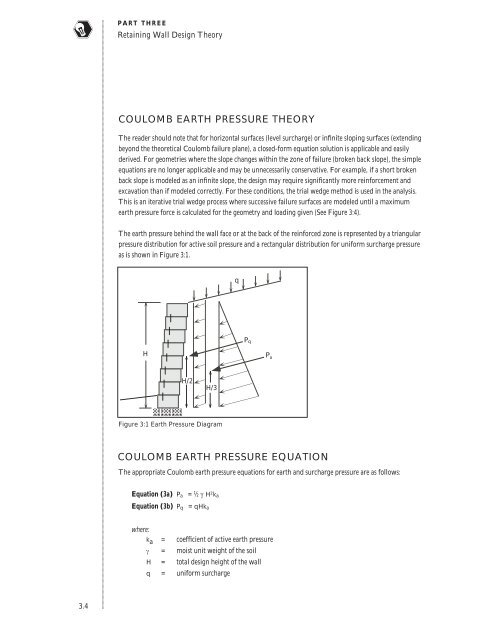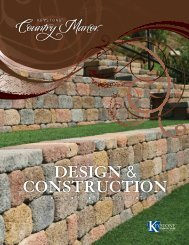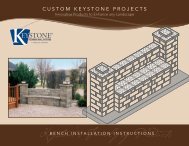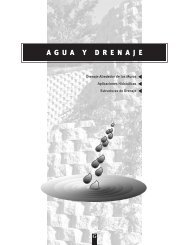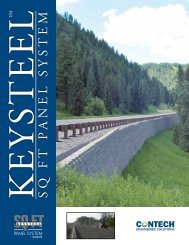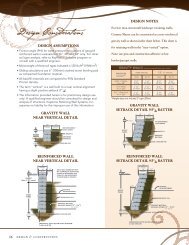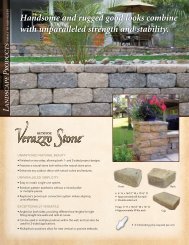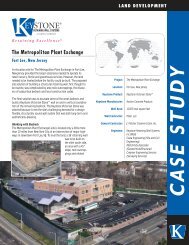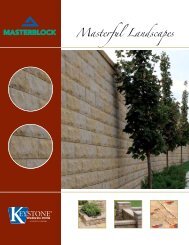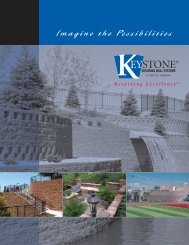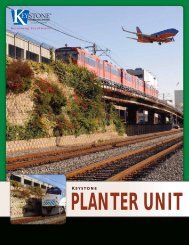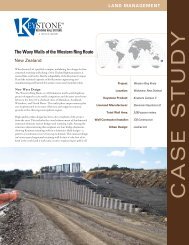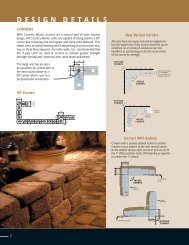- Page 5 and 6: INTRODUCTIONTable of ContentsTABLE
- Page 7 and 8: INTRODUCTIONTable of ContentsTABLE
- Page 10 and 11: DESIGN MANUAL& KEYWALL OPERATING G
- Page 12 and 13: DESIGN MANUAL& KEYWALL OPERATING G
- Page 14: PART ONEKEYSTONE ® RETAINING WALL
- Page 17 and 18: PART ONERetaining Wall UnitsKEYSTON
- Page 19 and 20: PART ONERetaining Wall Units133ELIT
- Page 21 and 22: PART ONERetaining Wall UnitsTYPICAL
- Page 24 and 25: DESIGN MANUAL& KEYWALL OPERATING G
- Page 26 and 27: DESIGN MANUAL& KEYWALL OPERATING G
- Page 28 and 29: DESIGN MANUAL& KEYWALL OPERATING G
- Page 30: PART THREERETAINING WALL DESIGN THE
- Page 33: PART THREERetaining Wall Design The
- Page 37 and 38: PART THREERetaining Wall Design The
- Page 39 and 40: PART THREERetaining Wall Design The
- Page 41 and 42: PART THREERetaining Wall Design The
- Page 43: PART THREERetaining Wall Design The
- Page 48 and 49: DESIGN MANUAL& KEYWALL OPERATING G
- Page 50 and 51: DESIGN MANUAL& KEYWALL OPERATING G
- Page 52 and 53: DESIGN MANUAL& KEYWALL OPERATING G
- Page 54 and 55: DESIGN MANUAL& KEYWALL OPERATING G
- Page 56 and 57: DESIGN MANUAL& KEYWALL OPERATING G
- Page 58 and 59: DESIGN MANUAL& KEYWALL OPERATING G
- Page 60 and 61: DESIGN MANUAL& KEYWALL OPERATING G
- Page 62 and 63: DESIGN MANUAL& KEYWALL OPERATING G
- Page 64 and 65: DESIGN MANUAL& KEYWALL OPERATING G
- Page 66 and 67: DESIGN MANUAL& KEYWALL OPERATING G
- Page 68 and 69: DESIGN MANUAL& KEYWALL OPERATING G
- Page 70: PART FIVEKEYWALL OPERATING INSTRUC
- Page 73 and 74: PART FIVEInstallation & User’s Gu
- Page 75 and 76: PART FIVEInstallation & User’s Gu
- Page 77 and 78: PART FIVEInstallation & User’s Gu
- Page 79 and 80: PART FIVEInstallation & User’s Gu
- Page 81 and 82: PART FIVEInstallation & User’s Gu
- Page 83 and 84: PART FIVEInstallation & User’s Gu
- Page 85 and 86:
PART FIVEInstallation & User’s Gu
- Page 87 and 88:
PART FIVEInstallation & User’s Gu
- Page 89 and 90:
PART FIVEInstallation & User’s Gu
- Page 91 and 92:
PART FIVEInstallation & User’s Gu
- Page 93 and 94:
DESIGN MANUAL& KEYWALL OPERATING G
- Page 95 and 96:
DESIGN MANUAL& KEYWALL OPERATING G
- Page 97:
DESIGN MANUAL& KEYWALL OPERATING G
- Page 100 and 101:
DESIGN MANUAL& KEYWALL OPERATING G
- Page 102 and 103:
DESIGN MANUAL& KEYWALL OPERATING G
- Page 104 and 105:
DESIGN MANUAL& KEYWALL OPERATING G
- Page 106 and 107:
DESIGN MANUAL& KEYWALL OPERATING G
- Page 108 and 109:
DESIGN MANUAL& KEYWALL OPERATING G
- Page 110 and 111:
PART SIXAPPENDIX CClay Terrace, Car
- Page 112 and 113:
CPART SIXAppendix CRANKINE METHODOL
- Page 114 and 115:
CPART SIXAppendix CRANKINE METHODOL
- Page 116 and 117:
CPART SIXAppendix CRANKINE METHODOL
- Page 118 and 119:
CPART SIXAppendix CRANKINE METHODOL
- Page 120 and 121:
CPART SIXAppendix CRANKINE METHODOL
- Page 123 and 124:
PART SIXAPPENDIX DGlasshoughton Rai
- Page 125 and 126:
DPART SIXAppendix D3H:1V SLOPING SU
- Page 127 and 128:
DPART SIXAppendix D3H:1V SLOPING SU
- Page 129 and 130:
DPART SIXAppendix D3H:1V SLOPING SU
- Page 131 and 132:
DPART SIXAppendix D3H:1V SLOPING SU
- Page 133 and 134:
DPART SIXAppendix D3H:1V SLOPING SU
- Page 135 and 136:
DPART SIXAppendix D3H:1V SLOPING SU
- Page 137 and 138:
DPART SIXAppendix D3H:1V SLOPING SU
- Page 140 and 141:
PART SIXAPPENDIX EPaige Residence,
- Page 142 and 143:
EPART SIXAppendix EAASHTO LRFD METH
- Page 144 and 145:
EPART SIXAppendix EAASHTO LRFD METH
- Page 146 and 147:
EPART SIXAppendix EAASHTO LRFD METH
- Page 148 and 149:
EPART SIXAppendix EAASHTO LRFD METH
- Page 150 and 151:
EPART SIXAppendix EAASHTO LRFD METH
- Page 152:
IDistributed By:We reserve the righ


